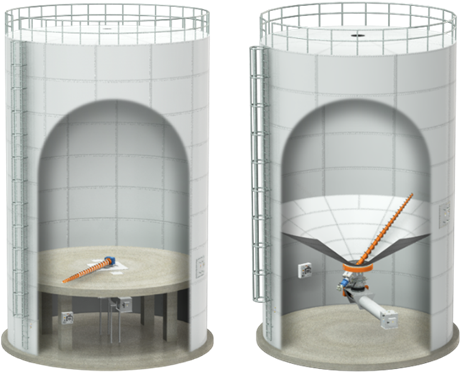Laidig is an industry leader in bulk storage and reclaim, specializing in systems for extracting hard-to-flow raw materials from conical and/or flat-bottom silos.
When materials stored in silos do not discharge properly, two types of actions are typically taken:
- For large silos: Workers enter to manually unload the material with shovels.
- For smaller silos: The walls or cone of the silo are struck to dislodge the material and enable flow.
In either case, these methods have significant drawbacks. In the first, there is a severe risk to human life, and in the second, long-term damage occurs due to dents in the silos. At Clivio Solutions, we offer the ideal solution to prevent workers from entering silos or striking their walls.
Key advantages of Laidig extractor systems include:
- Safety: Eliminates life-threatening risks for operators.
- Sanitation: Prevents rat holing and material buildup.
- Traceability: Ensures FIFO (First In, First Out) system compliance.
- Capacity: Enables complete filling and emptying of silos, maximizing their capacity.

In the following video, we can see a comparison between silos that do not have a Laidig system and silos that do. This clearly demonstrates the significant advantages mentioned earlier.
If you have a conical silo, the ideal equipment for your application is the Cone Bottom model (available in electric and hydraulic versions, depending on your requirements).
If you are looking for a solution for flat-bottom silos and low-flow materials, such as animal-derived flours or soy paste, the suitable reclaimer models are the X-tractor, Cantilever, or Track-Drive. For these applications, the silo can operate fully loaded, and discharge will be efficient and safe thanks to the reclaimer, which keeps the bottom 100% active during the unloading process.
If you need to sweep the bottom once the product stops flowing freely by gravity, the suitable model is the Clean Sweep. This silo bottom sweeper activates only for the final product discharge and cleaning, making it a very common solution for grains, legumes, or free-flowing products.
No matter the discharge issue with your silo, together with Laidig, we have the ideal solution to protect your company's team and prevent risks.

